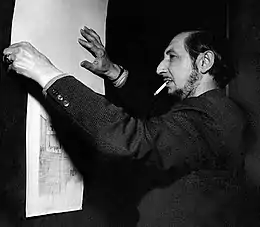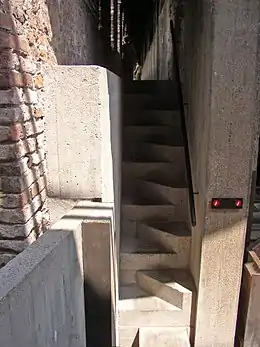Carlo Scarpa
Carlo Scarpa (2 June 1906 – 28 November 1978) was an Italian architect, influenced by the materials, landscape and the history of Venetian culture, and by Japan.[1] Scarpa translated his interests in history, regionalism, invention, and the techniques of the artist and craftsman into ingenious glass and furniture design.[2][3][4]


_-_BEIC_6337280.jpg.webp)
Biography
Scarpa was born in Venice. Much of his early childhood was spent in Vicenza, where his family relocated when he was 2 years old. After his mother's death when he was 13, he moved with his father and brother back to Venice. Carlo attended the Academy of Fine Arts where he focused on architectural studies. Graduated from the Accademia in Venice, with the title of Professor of Architecture, he apprenticed with the architect Francesco Rinaldo. Scarpa married Rinaldo's niece, Nini Lazzari (Onorina Lazzari).
However, Scarpa refused to sit the pro forma professional exam administered by the Italian Government after World War II. As a consequence, he was not permitted to practice architecture without associating with an architect. Hence, those who worked with him, his clients, associates, craftspersons, called him "Professor", rather than "architect".
His architecture is deeply sensitive to the changes of time, from seasons to history, rooted in a sensuous material imagination. He was Mario Botta's thesis adviser along with Giuseppe Mazzariol; the latter was the Director of the Fondazione Querini Stampalia when Scarpa completed his renovation and garden for that institution. Scarpa taught drawing and Interior Decoration at the "Istituto universitario di architettura di Venezia" from the late 1940s until his death. While most of his built work is located in the Veneto, he made designs of landscapes, gardens, and buildings, for other regions of Italy as well as Canada, the United States, Saudi Arabia, France and Switzerland. His name has 11 letters and this is used repeatedly in his architecture.[5]
One of his last projects, the Villa Palazzetto in Monselice, left incomplete at the time of his death, was altered in October 2006 by his son Tobia. This work is one of Scarpa's most ambitious landscape and garden projects, the Brion Sanctuary notwithstanding. It was executed for Aldo Businaro, the representative for Cassina who is responsible for Scarpa's first trip to Japan. Aldo Businaro died in August 2006, a few months before the completion of the new stair at the Villa Palazzetto, built to commemorate Scarpa's centenary.
In 1978, while in Sendai, Japan, Scarpa died after falling down a flight of concrete stairs. He survived for ten days in a hospital before succumbing to the injuries of his fall. He is buried standing up and wrapped in linen sheets in the style of a medieval knight, in an isolated exterior corner of his L-shaped Brion Cemetery at San Vito d'Altivole in the Veneto.
In 1984, the Italian composer Luigi Nono dedicated to him the composition for orchestra in micro-intervals A Carlo Scarpa, Architetto, Ai suoi infiniti possibili.[6]
Notable works
- Gallerie dell'Accademia, Venice, Italy[7]
- Padiglione del libro d'arte, Giardini di Castello, La Biennale, Venice, 1950–1952 [8]
- Palazzo Abatellis: La Galleria Di Sicilia, Palermo, 1953–1954 [9]
- Palazzo Ca'Foscari, Venice, Italy, 1935–1956
- Venezuelan Pavilion, La Biennale, Venice, Italy, 1954–1956[10]
- Veritti House, Udine, Italy, 1955–1961 [11]
- Museo Canova di Possagno, Italy, 1955–1957 [12]
- Museo di Castelvecchio, Verona, Italy, 1956–1964 [13]
- Negozio Olivetti, piazza S. Marco, Venezia, Italy, 1957–1958 [14]
- Fondazione Querini Stampalia, Venice, 1961–1963 [15][16]
- Brion Tomb and Sanctuary, at San Vito d'Altivole, Italy, 1969–1978 [17]
- Banca Popolare di Verona, Italy, 1973–1978 [18]
- Restauración del Museo de Castelvecchio en Verona / Carlo Scarpa[19]
Design career
Carlo Scarpa was a designer too. At the beginning of his career, he collaborated with glassmakers in Murano. He designed jars and chandeliers for MVM Cappellin & Co. and Venini.
Furthermore, he joined the industrial design world in the 1960s after meeting Dino Gavina. Indeed Scarpa became the president of the eponymous company Gavina.
In 1968, after the founding of Studio Simon, Carlo Scarpa started to design industrial furniture.
He projected pieces for Simon and Bernini.
The Doge table (1968) and the Cornaro sofa (1973) are the most famous.[20]
Bibliography
- (in Italian) Francesco Dal Co; Giuseppe Mazzariol (1984). Carlo Scarpa: opera completa. Milan: Electa.[21]
- Francesco Dal Co; Giuseppe Mazzariol (1985). Carlo Scarpa: The Complete Works. Milan: Electa; New York: Rizzoli.
- Maria Antonietta Crippa, edited by Marina Loffi Randolin. (1986). Carlo Scarpa: Theory, Design, Projects. Cambridge, Massachusetts: MIT Press.[22]
- Nicholas Olsberg, et al. (1999). Carlo Scarpa, Architect: Intervening with History. Montréal, Quebec: Canadian Centre for Architecture; New York: The Monacelli Press.[23]
- (in Italian) Sergio Los (1967). Carlo Scarpa: architetto poeta. London: RIBA.[24]
- (in Italian) Sergio Los (1995). Carlo Scarpa: guida all’architettura. Venice: Arsenale.[25]
- (in Italian) Carla Sonego (1995). Carlo Scarpa. Gli anni della formazione. Venice: IUAV, (unpublished thesis, Professor Marco De Michelis, supervisor).
- Anne-Catrin Schultz (2007). Carlo Scarpa: Layers. Stuttgart: Edition Axel Menges.
- Guido Beltramini, Italo Zannier (2007). Carlo Scarpa: Architecture and Design. New York: Rizzoli.
- Sergio Los (2009). Carlo Scarpa: 1906-1978: A Poet of Architecture. Köln: Taschen.[26]
- Francesco Dal Co (2009). To Construct, to Compose: Carlo Scarpa and the Villa Ottolenghi. Amsterdam: SUN.
- Guido Guidi (2011). Carlo Scarpa's Tomba Brion. Ostfildern: Hatje Cantz.
- (in Italian) Franca Semi (2010). A lezione con Carlo Scarpa. Venice: Cicero.[27]
- Robert McCarter (2013). Carlo Scarpa. London: Phaidon Press. (2nd edition 2017)
Giunta, Santo (2020), Carlo Scarpa. A [curious] shaft of light, a golden standard, the hands and a face of a woman. Reflections on the design process and layout of Palazzo Abatellis 1953-1954. Foreword by Richard Murphy; Afterword by Giampiero Bosoni, Marsilio, Venice, ISBN 978-88-297-0654-9.
References
- Carlo Scarpa and Japan. The influence of Japanese art and architecture in the work of Carlo Scarpa. lincoln.ac.uk
- Albertini, Bianca; Bagnoli, Alessandro (1988). Carlo Scarpa: Architecture in Details. Cambridge, Massachusetts: MIT Press. ISBN 0262011077.
- Barovier, Marina (1991). Carlo Scarpa: I Vetri Di Murano 1927-1947. Venezia : Il cardo. OCLC 26484061.
- Smith, Roberta (5 December 2013). "Clear, Opaque and Oh, So Delizioso 'Venetian Glass by Carlo Scarpa' at the Met". The New York Times.
- Frascari, Marco (June 1999). "Architectural Traces of an Admirable Cipher: Eleven in the Opus of Carlo Scarpa". Nexus Network Journal. 1 (1–2): 7–22. doi:10.1007/s00004-998-0002-4.
- "A Carlo Scarpa, architetto, ai suoi infiniti possibili". Archivio Luigi Nono (Luigi Nono Archive). Retrieved 3 April 2020.
- Scarpa carried out "sensitive restoration work" on the building."Carlo Scarpa, Architect". understandingitaly.com. Retrieved 17 January 2017.
- Museo Nazionale della Arti Dell XXI Secolo (1950). "Collezioni XX secolo torna indietro Padiglione del libro d'arte, Giardini di Castello". MAXXI. Archived from the original on 28 September 2015. Retrieved 27 September 2015.
- Polano, Sergio (1989). "Carlo Scarpa: Palazzo Abatellis : La Galleria della Sicilia, Palermo 1953-54". Milan : Mondadori Electa.
- Scarpa, Carlo. "Venezuelan Pavilion (1954-56), Venice Architecture Biennale 2014". La Biennale. Archived from the original on 21 September 2015. Retrieved 27 September 2015.
- Olsberg, Nicholas; Ranalli, George; Bedard, Jean-Francios; Polano, Sergio; Di Lieto, Alba; Friedman, Mildred (1999). "Carlo Scarpa, architect : Intervening With History". Getty Search Gateway. Montreal, Quebec, Canada : Canadian Centre For Architecture New York : Monacelli Press.
- "L'ampliamento di Scarpa al Museo di Possagno". Museo Canova.
- Murphy, Richard (1990). "Carlo Scarpa and the Castelvecchio". London ; Boston : Butterworth Architecture, 1990.
- Camerlengo, Lia (1984). "Negozio Olivetti, Procuratie vecchie, piazza S. Marco, Venezia, 1957 – 1958". Getty Search Gateway. Milano : Electa. p. 120.
- "Carlo Scarpa". Fondazione Querini Stampalia.
- Murphy, Richard (1993). "Querini Stampalia Foundation : Carlo Scarpa". Getty Search Gateway. London : Phaidon.
- Duboy, Phillipe; Noever, Peter; Noever, editor, Peter (1989). "Carlo Scarpa : the other city : the architect's working method as shown by the Brion cemetery in San Vito d'Altivole". Getty Search Gateway. Berlin : Ernst & Sohn.
{{cite web}}:|first3=has generic name (help)CS1 maint: multiple names: authors list (link) - Olsberg, Nicholas; Ranalli, George; Bedard, Jean-Francios; Polano, Sergio; di Lieta, Alba; Friedman, Mildred (1999). "Carlo Scarpa, architect : intervening with history". Getty Search Gateway. Montreal, Quebec, Canada : Canadian Centre For Architecture ; New York : Monacelli Press.
- "Clásicos de Arquitectura: Restauración del Museo de Castelvecchio en Verona / Carlo Scarpa". ArchDaily México (in Mexican Spanish). 18 June 2014. Retrieved 10 January 2023.
- "Carlo Scarpa, When Design Comes from Creativity". Italian Design Club. 18 January 2022. Retrieved 14 February 2022.
- Dal Co, Francesco; Mazzariol, Giuseppe (1984). "Carlo Scarpa : opera completa". Getty Search Gateway. Milano : Electa.
- Crippa, Maria Antonietta.; Loffi Randolin, Ed. Marina (1986). "Carlo Scarpa : theory, design, projects". Getty Search Gateway. Cambridge, Massachusetts : MIT Press.
- Olsberg, Nicholas; Ranalli, George; Polano, Sergio; Di Lietio, Alba; Freidman, Mildred; Bedard, Jean-Francois; Guidi (photographer), Guido (1 May 1999). Carlo Scarpa, Architect: Intervening with History (First ed.). Canadian Centre For Architecture. p. 256. ISBN 1580930352.
- Los, Sergio (1994). "Carlo Scarpa, architteto poeta". Getty Search Gateway. London : RIBA.
- Los, Sergio (1995). "Carlo Scarpa : guida all'architettura". Venezia : Arsenale.
- Los, Sergio (2002). Carlo Scarpa. Köln ; London Los Angeles Madrid Paris Tokyo : Taschen. ISBN 3822821128.
- Semi, Franca (2010). A Lezione con Carlo Scarpa. Venezia : Cicero. ISBN 9788889632260.
Giunta, Santo (2020), Carlo Scarpa. A [curious] shaft of light, a golden standard, the hands and a face of a woman. Reflections on the design process and layout of Palazzo Abatellis 1953-1954. Foreword by Richard Murphy; Afterword by Giampiero Bosoni, Marsilio, Venice, ISBN 978-88-297-0654-9.